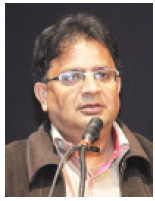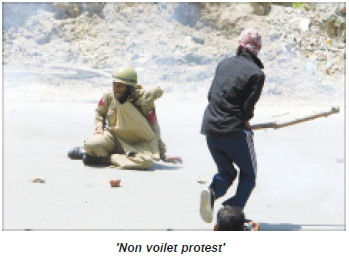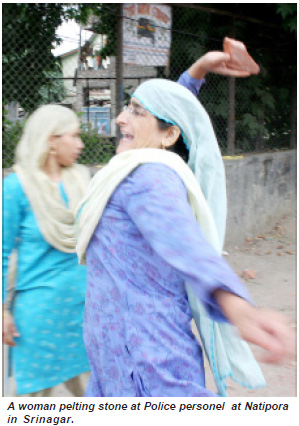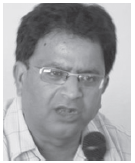This write-up was published on the building
‘intifada’ in Kashmir one year back. We are reproducing it again because we
feel it reflects the intricacies of the situation in Kashmir in depth and
detail. We have also incorporated some portions of this write-up in the
editorial of this issue as we think it very relevant to the present situation
in the state.
July 2010
 The
tactical dimensions of the Intifada in Kashmir valley are coming to the fore
sooner than later. Any doubts that the recent public mobilisation drives in
Kashmir Valley have been deft manoeuvres to create space for both Pakistani
Government and the separatists in Jammu and Kashmir state in the existing
international environment should by put aside taking due notice of what is
emerging from Pakistani side at unofficial as well as official level.
The
tactical dimensions of the Intifada in Kashmir valley are coming to the fore
sooner than later. Any doubts that the recent public mobilisation drives in
Kashmir Valley have been deft manoeuvres to create space for both Pakistani
Government and the separatists in Jammu and Kashmir state in the existing
international environment should by put aside taking due notice of what is
emerging from Pakistani side at unofficial as well as official level.
The views of high profile former ambassador of Pakistan to USA Miss Maleeha
Lodhi which appeared in press recently are pertinent in this respect. She very
clearly acknowledges a linkage between the public protests in Kashmir Valley
last year during the Amarnath Land Row and the spate of protest campaigns
there after the discovery of female bodies in Shopian. “The year 2008
witnessed the highest number of anti-India protests in Kashmir’s recent
history. The catalyst was the controversial government decision to transfer
forest land to the trust that administered the Hindu Amarnath Shrine…….This
was no passing episode as the renewal of protests in 2009 testifies.” Ms
Maleeha Lodhi also alludes to the immediate political objective of the
continuing intifada in the Valley.Ms Lodhi says, “to understand these
questions, it is necessary to place them in the context of what has been
happening in Jammu and Kashmir since 2008. This is the year the Indian
authorities declared as the most non-violent since 1989, when Kashmir uprising
began. The militancy according to Indian officials had been crushed. A
relative though surface calm prevailed…The eruption of protests shattered this
allusion of normalcy”.

The eloquent Pakistani diplomat further underlines the tactical
perspectives as recognised in Pakistan about the intifada in Kashmir by
raising the question, “what could happen if the Kashmiri struggle that has
increasingly assumed the shape of a non-violent movement fails to achieve its
objectives, if its grievances are not addressed; if the stalled Pakistan
dialogue is unable to alleviate the demands of the movement? will this be a
game changer?”
After the Kargil war, the Intifada in Kashmir Valley is being employed as
one more game changer. The hope is to break the status quo of Indian position
in Jammu and Kashmir. To impart sufficient momentum to this ‘game changer’
Pakistani government has come out for the first time to support the
proposition of ‘independent Kashmir’. A day before Maleeha Lodhi’s views
appeared in the press the Pakistani foreign office spokesman Abdul Basit made
a statement on August 5 articulating this stand, “There, has been no change in
our foreign policy. We want an independent Kashmir. We want the Kashmir issue
to be resolved in accordance with the wishes of people.” Having given this
signal Pakistan recaliberated its international stand to the previous
non-committal posture on the issue of ‘Independence’ to Kashmir. Responding to
various questions on Kashmir the Foreign Minister of Pakistan stated, “Kashmir
is still an outstanding issue and Pakistan wants its solution according to UN
resolution through plebiscite.”
The to and fro-postures of Govt of Pakistan on the third option
(independence) have been aimed at widening the space of Pakistan’s
manoeu-vrability with separatists, Amer-icans, the entrenched subversive class
in India and facilitate cooperation between pro-Pak and pro-Independence
groups operating in Jammu and Kashmir. At more subtle level Pakistan is aiming
to deepen the ideological wedge between the National Conference and the
Congress, the parties which are in alliance and running the government in the
state.
NC’s response to Pakistani postures has been on expected lines. Its MLA
from Hazratbal constituency and the younger brother of NC patron Dr. Farooq
Abdullah responded to Pakistani stance by stating, “Pakistan is now pleading
for independent status for Jammu and Kashmir…It is a welcome step”. Dr. Kamal
referred to Late Sheikh Moh. Abdullah’s interview given to London observer in
1948 in response to the establishment of UN Commission for India and Pakistan
to play the role of mediator on Kashmir issue and claimed that Sheikh Abdullah
had said then, ‘the only viable option would be for Jammu and Kashmir to have
a neutral status vis-a-vis both India and Pakistan. However because of
ruptured politics within Jammu and Kashmir and given the diverse political,
religious and ethnic affiliations within it, the sovereign and autonomous
status of the state would need to be acknowledged and guaranteed not just by
India and Pakistan but by the United Nations and the World Powers as well”.
During the incaceration of Sheikh as well as after his release right till his
death NC had maintained that charges to sedition against him were false and
fabricated.
Through Dr Kamal’s response NC aims to claim a moral vindication for its
politics which has vacillated between the stance of maximum autonomy and
Independence over the years. Through the Kamal’s posturing NC also has sought
to preserve the space of deniability to ensure minimum strain on its alliance
with the Congress party. Dr. Mustafa Kamal did seek an apology from Pakistan
for the tribal raid in 1947 but its purpose seems less to embarrass Pakistan
and more to placate Indian opinion. The sudden and open espousal of
independence by one of the credible faces of Sheikh’s family reminds one of
the sudden release of Greater Autonomy report by NC in its previous tenure.
That time Kathwari visit to India and his plan was the catalyst. This time it
is perhaps the realisation of the widening support in Pakistani establi-shment
for ‘Independence’. Pakistan’s foreign office spokesman while supporting
independence option virtually recognised it as the dominant wish of the people
of Kashmir.
Both the separatist establishment in Jammu and Kashmir and Govt. of
Pakistan are building a core theme which they hope would crystallise enough
support from USA, Europe and more crucially within India for a change of
status quo in Jammu and Kashmir. The features of this theme are that the
separatist movement in Kashmir is purely an indigenous phenomenon; separatism
in Kashmir is a mass movement which graduated into a violent phase in 1989-90
only after the failure of its non-violent phase; the movement has once again
rediscovered its non-violent character through the present intifada providing
a unique opportunity for peace; the democratic dispensation in the state is
only a makeshift arrangement which is incapable of mitigating the injustice of
Indian imperialism; separatists and Pakistan are open to all solutions of
changing the status quo in Kashmir which includes greater autonomy, self-rule
and even Independence; finding a solution as per the wishes of people of
Kashmir will create a congenial atmosphere for defeating terrorism in the
region and last but not the least as per Ms Lodhi ‘tensions between the
nuclear neighbours can easily be reignited by turmoil in the Valley. Paralysis
in peace making and international apathy only heightens the danger in a
volatile region that is poised at a tipping point”.
Indian state is facing a serious predicament in its Kashmir policy. This
predicament is mostly self created. Instead of contesting and exposing the
regressive content of various variants of separatism in Kashmir, GoI has, over
the years concentrated mostly in transforming its violent expressions into
non-violent form. GoI has been more ill at ease only with the violence of
separatists rathen than their ideology. While doing so it conveyed implicitly
as well as explicitly that it was violence which was taking the separatism
towards a regressive manifestation. GoI never exerted itself to bring to the
fore that the violence unleashed in the state was inevitable consequence of
the regressive exclusivist content of separatism. When GoI started describing
terrorism as militancy and terrorists as misguided youth it has been not
merely a cosmetic or tactical ploy but reflected the outlook which guides its
Kashmir policy. This outlook accords respectability to separatist cause.
The attitude of not contesting ideology of separatism is explained as a
deft physiological intervention which seeks to minimise the affront to
separatists mind with the hope of taming it.Gross distortions of Kashmir’s
history are allowed to be carried forward as gospel truths under the cover of
this attitude. The separatist think-tank uses this space to project the
blatant falsehoods like Kashmir being an unfinished agenda of partition,
article 370 having a treaty status between two sovereign bodies namely
constituent assembly of India and Constituent Assembly of Jammu and Kashmir
which was eroded unilaterality by India absolving Kashmiris of any obligation
to respect accession, Kashmiris had signed only an instrument of accession and
not instrument of merger and that is why Jammu and Kashmir is still not an
indivisible part of Union of India, so on and so forth. Such falsehoods have
sustained separatists consciousness. GoI instead of putting facts in correct
perspective has sought to convey that Indian Constitutional organisation was
flexible enough to even provide space for autonomies based on religious
identity with only the sky as their limit. As the non-violent intifada unfolds
in the Valley GoI is caught on the wrong foot. It has through its own outlook
armed separatism with respectibility and disarmed itself of legitimate and
crucial arguments.
The predicament is not merely how to counter the thrust of a non-violent
mass mobilisation. GoI is in fact face to face with a dangerous cocktail of
non-violent Intifada and caliberated violent Jihad. Recent events in the state
have shown that violence has not abated at all in intensity or sophistication.
In the first week of August at least 18 militants, five troopers and two
civilians were killed in Jammu and Kashmir in militancy related violence. Gun
battles lasted for days forcing even the army chief to admit that militants
‘have changed tactics’. With Pakistan seeming to succeed in convincing the
world at large that it was distancing from sponsoring the terrorism in J&K and
other parts of India, it continues to threaten the world that autonomous
terrorists regimes may crystallise an event which can lead to a war between
India and Pakistan. It stresses a solution to Kashmir problem as an imperative
so that the present non-violent phase of separatist upsurge is not allowed to
relapse into violence bedevilling peace in the region
Indian predicament only deepens the way it has allowed the elected
democratic dispensations to be undermined by none other than the elected
governments themselves. GoI facilitated PDP’s emergence on a soft secessionist
plank. It introduced fierce competitive secessionism between PDP and NC on the
ground. When PDP lead government assumed reigns, its leader described the
elected government as merely an interface between Pakistan, India and people
of Jammu and Kashmir. Impression has been inculcated that elections are merely
a makeshift arrangement for day to day requirements.
The presently ruling NC, taking a cue from PDP even before getting elected,
described elections not a solution but only a day-to-day use arrangements.
Hundreds of political workers have perished during the democratic mobilisation
in the state during last one decade. When the world started recognising J&K
elections as credible GoI allowed the governments, of which it was a partner,
to undermine their own legitimacy and credibility by describing themselves as
mere ‘interfaces’ or temporary arrangements. The entire democratic
mobilisation against the blackmail of armed separatism was disowned by
allowing ‘Soft Secessionism’ as a guiding principle of Governance.

Democracy in the state has assumed a form which seeks a reach beyond the
Constitution of India. It has started ceasing to be an expression of sharing
the sovereignty of India on a principal of equality. Instead GoI has allowed
the democracy in the state to unleash assaults on the very sovereignity of
India. We have now a government in the state whose front partner does not
hesistate to support ‘Independence’ of the state. The separatism has a partner
in the government which otherwise is expected to fight separatism.
Last but not the least the GoI has allowed segments of our own strategic
community and track-2 diplomats to flirt with ideas of Independence of J&K or
fully autonomous J&K. These ideas have been introduced from our side and the
rationale provided has been that counterpoising these options would checkmate
Pakistan in Jammu and Kashmir. With Pakistan giving clear indications of
supporting both autonomy and Independence options GoI appears to have only
checkmated its ownself.
The indulgence of a section of Indian State in promoting religious based
identity politics in Jammu and Kashmir including the options of Greater
Autonomy and Independence has not been always very subtle. It has been many
times crude and ugly. During the IInd Round Table Conference on Kashmir
organised at the behest of Dr. Manmohan Singh in Srinagar
one of the delegates, the then MLA from Bandipora Sh Usman Majid, posed the
following to the Prime Minister of India “Sir, you are witnessing the violence
and shutdown in the Valley during this conference. Why was the Jamaat Chief
Ali Shah Geelani released just a few days before this conference? If he was
released why was he allowed to hold a rally near the airport itself? Who
advised the government on this account? Do you known sir that the flags
hoisted there were that of Lashkar-e-Toiba? Do you know sir what where the
slogans which were raised there – Lashkar Aayee Lashkar aayee-Manmohan Ki Maut
aayee, Lashkar-aayee, Lashkar aayee-Aazad Ki Maut Aayee” His posers forced
some of us who were also delegates to the conference to ponder subsequently.
We asked ourselves a question – was Geelani released to raise more radical
noises outside to make us recognise that by comparison the ‘self-rule’ slogan
of PDP and ‘Greater Autonomy’ slogan of NC, were moderate options and as such
should command our support? was GoI itself promoting the ideas of
‘self-rule’and ‘greater autonomy’. During the entire mobilisation for the
present intifada in Kashmir Jamaat and Dukhtaran-e-Millat cadres have been
given a free hand last year as well as this year.There are very few persons
who know that none other than former Pakistan Army Chief Mirza Aslam Beg is on
record of saying that even Jamaat of Kashmir may support autonomy or
independence.
The predicament which Indian state has built in its handling of Kashmir is
gradually turning into a self goal for an ignominious defeat.









 The
tactical dimensions of the Intifada in Kashmir valley are coming to the fore
sooner than later. Any doubts that the recent public mobilisation drives in
Kashmir Valley have been deft manoeuvres to create space for both Pakistani
Government and the separatists in Jammu and Kashmir state in the existing
international environment should by put aside taking due notice of what is
emerging from Pakistani side at unofficial as well as official level.
The
tactical dimensions of the Intifada in Kashmir valley are coming to the fore
sooner than later. Any doubts that the recent public mobilisation drives in
Kashmir Valley have been deft manoeuvres to create space for both Pakistani
Government and the separatists in Jammu and Kashmir state in the existing
international environment should by put aside taking due notice of what is
emerging from Pakistani side at unofficial as well as official level.






No one has commented yet. Be the first!